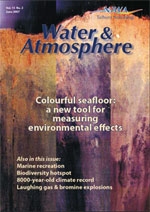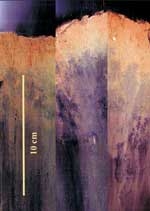PDF of this article (567 KB)



Kay Vopel, Hilke Giles,, and John Zeldis have combined three existing tools to come up with a new way of assessing change in coastal ecosystems.
Sediments in coastal ecosystems have the job of breaking down organic matter. In a complex system of microbial activities and chemical reactions, organic matter is transformed to inorganic forms through a variety of pathways. Some of these paths return dissolved nutrients for the growth of algae living on the sediment or in the water; others produce ‘unwanted’ gases, such as the odorous hydrogen sulphide and methane. Bacteria play the most important part in the breakdown of organic matter but other organisms, such as worms, crustaceans, and larger bottom-dwelling creatures, also have important roles.
Sediment and ecosystem function
NIWA scientists investigating this ecosystem function are particularly interested in how the transformation of organic matter in coastal sediment changes under various scenarios of environmental effects. For example, what changes might we find in sediments under mussel or fish farms or in estuaries that receive wastewater? We believe that understanding the breakdown of organic matter in the sediment is a key for predicting the capacity of New Zealand’s coastal ecosystems to withstand environmental effects, and for assessing the success or failure of remediation efforts.
A new seafloor-monitoring tool
To transfer our knowledge into cost-effective tools for environmental protection, we’re developing a new seafloor monitoring tool that combines the power of two state-of-the-art field measuring techniques with that of a sophisticated model of organic matter breakdown. Each of these techniques on its own is not new; they have all been used overseas to investigate sediment processes. However, recent technical advances have made it possible to combine them in a unique way.
Reading sediment colour
Our new tool takes advantage of a simple sediment property – its colour – or, more precisely, changes in colour with depth. These colour profiles in the sediment result from the mineral composition of the sediment and microbial reduction–oxidation (or redox) reactions. The reactions, which lead to the breakdown of organic matter, move electrons between organic matter and sediment-colouring compounds such as iron, manganese, and sulphur.
Iron minerals provide the greatest variety of pigments by far. For example, large crystals of goethite (FeOOH) give the yellow pigment of aerobic sediment, and smaller goethite crystals produce shades of brown. Hematite (Fe2O3 – Greek for blood-like) adds rich red tints, ferrihydrite (Fe (OH)3) adds dark red tints, and lepidocrocite (FeOOH – same formula as goethite but different crystal structure) gives orange pigments.
Lack of colour also tells something about the sedimentary processes. Some bacteria transfer electrons to ferric iron (Fe3+)in goethite and hematite; in the process, iron is reduced to colourless, water-soluble ferrous iron (Fe2+). Other bacteria reduce solid manganese to a colourless, soluble form (Mn2+). Bacteria can reduce sulphate to sulphide (S2–), which combines with ferrous iron to precipitate black iron sulphide (FeS). With time, iron sulphide alters to pyrite (FeS2) and imparts a remarkable metallic bluish colour.
Technical challenges
Reading sediment colour is not a trivial exercise. First of all, it means studying complicated chemical processes acting on sediment, such as the weathering of geologic material, the chemistry of redox reactions upon the various minerals, and the biochemistry of the breakdown of organic matter.
Secondly, it means dealing with technical difficulties. For example, the perception of sediment colour depends on the light conditions and the sediment water content. Differences in the mineral composition of sediments around New Zealand’s coast complicate comparison between environments. Combined with a proper analysis of the local sediment chemistry, however, reading sediment colour profiles can be a powerful tool.
To solve some of these technical issues and to adjust our numerical sediment model to the regional sediment chemistry, we use two novel underwater instruments. The first instrument is an in-situ microelectrode pore-water analyser. It can measure the chemistry of the sediment by microelectrodes inserted into the sediment; the instrument makes automated measurements at a spatial resolution of less than tenths of a millimetre. The second is an imaging device that pushes a scanner into the sediment and makes high-resolution digital scans of the sediment under well-defined lighting conditions. The sediment model simulates the different pathways of organic matter breakdown and the concentrations of compounds which can be used to help interpret sediment colours. The main purpose of the model is to predict changes in the sediments following a change in environmental conditions.
Many applications
There is still a long way to go, but, with fine-tuning, this three-technique monitoring tool has many applications. For example, we can use it to assess potential risks involved with marine aquaculture, agriculture and urban development in coastal regions, and coastal dredging and construction activities.
The tool’s first two trials took the scientists to the mussel farms in Wilson Bay, Firth of Thames, and to the Avon-Heathcote Estuary, Christchurch, earlier this year. At present the estuary receives treated wastewater from the Christchurch Wastewater Treatment Plant; in 2008 this wastewater stream will be diverted to a new outfall in Pegasus Bay. Using our new tool in combination with other monitoring techniques, we are measuring the response of the estuary sediment to a decrease in pollution. Our findings will inform conclusions about the remediation of the estuary as a whole.
Reading the sediment
- Sediment colour reveals a lot about biogeochemical processes and ecosystem health.
- A new environmental-assessment tool combines two in-situ measuring techniques and a model to analyse sediments.
- The first uses of the tool will be in monitoring effects of aquaculture in the Firth of THames and efforts to clean up the Avon-Heathcote Estuary.
Dr Kay Vopel is a benthic ecologist and Dr Hilke Giles works as a postdoctoral fellow, modelling sediment biogeochemistry; they are based at NIWA in Hamilton. Dr John Zeldis is a biologist who works at NIWA in Christchurch on marine ecosystems and aquaculture.
Special thanks go to Peter Wilson, a Masters student at Waikato University. This project is partly funded by NIWA and the Foundation for Research, Science and Technology ‘Sustainable Aquaculture’ programme.
Teachers’ resource for NCEA Achievement Standards or Unit Standards: Chemistry Level 1 AS90170, Level 2 US8947, Level 3 US6340 Science Level 1 US6349 Technology Level 1 AS90051 See other curriculum connections
